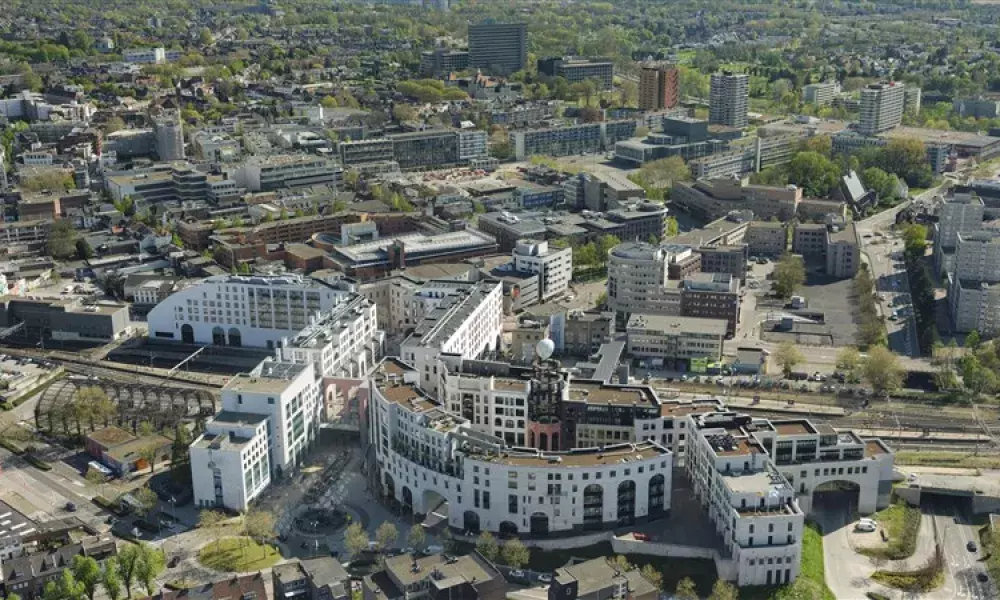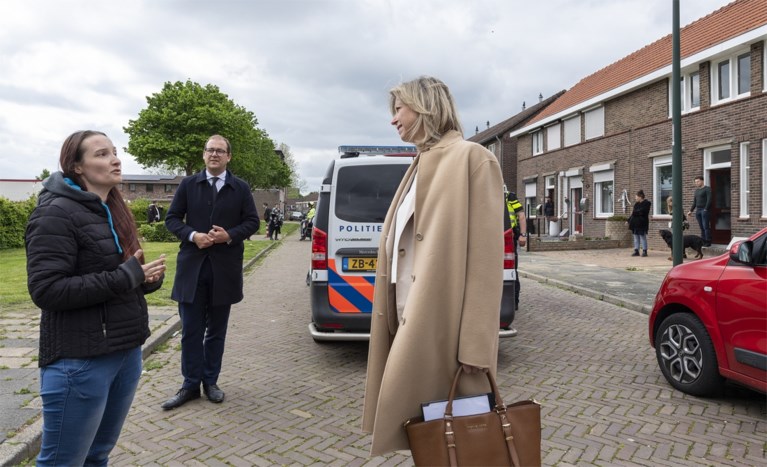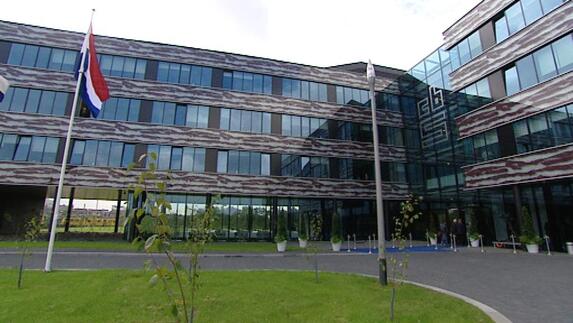
After the closure of the last State Mine in the 1970s, the Dutch government applied a couple of measures to replenish the lost jobs in the Southern Limburg region. One of them was moving some of its national institutions to Heerlen, such as Statistics Netherlands (CBS). Although adding white collar jobs for the blue collar unemployed was mostly ineffective as such, Heerlen has since become home to a centre of outstanding statistics research. “Since 2009 we have been conducting a very large scale survey research on social cohesion and wellbeing in the Netherlands, including in fifty of the largest cities and towns,” Professor Hans Schmeets starts off. “You see that Heerlen still has a lot of catching up to do: they make the bottom of the league on more than a few occasions.” His colleague Tim Muller jumps in: “But we tend to look at it differently. If Heerlen has the least share of volunteers of all Dutch cities for example, that also means the potential is huge. So for a project like WESH to try out, Heerlen just seems to be the right place.”
"In our monitoring we focus the social effects of the project on the local population"
One-sided story
As a researcher at Statistics Netherlands, Professor Hans Schmeets has built up an impressive track record over the last two decades. He has over 200 publications to his name, which show his particular interest in all aspects of social cohesion. Since 2008 he is a part-time Professor at Maastricht University, where he holds a Special Chair in Social Statistics. “If you look at Heerlen’s statistics, the numbers can tell you a one-sided story,” Professor Schmeets explains. “So the local trust, political engagement and the number of volunteers are all relatively low, but you have to understand a few things. They are rooted for example in the high unemployment rate and a fair share of migrants and elderly citizens.” Tim Muller is coordinating the Urban Data Centres, which Statistics Netherlands has set up in 14 places throughout the country. For Heerlen he has been conducting research on social disadvantages of its younger population, providing specific insights in order to create equal opportunities at the start of children's lives. “Since we know that birth weight and family circumstances in Heerlen deviate from the national average, the local authorities can take much more effective measures to counter the risks they have on the future generation Heerleners,” Tim explains.
As a researcher at Statistics Netherlands, Professor Hans Schmeets has built up an impressive track record over the last two decades. He has over 200 publications to his name, which show his particular interest in all aspects of social cohesion. Since 2008 he is a part-time Professor at Maastricht University, where he holds a Special Chair in Social Statistics. “If you look at Heerlen’s statistics, the numbers can tell you a one-sided story,” Professor Schmeets explains. “So the local trust, political engagement and the number of volunteers are all relatively low, but you have to understand a few things. They are rooted for example in the high unemployment rate and a fair share of migrants and elderly citizens.” Tim Muller is coordinating the Urban Data Centres, which Statistics Netherlands has set up in 14 places throughout the country. For Heerlen he has been conducting research on social disadvantages of its younger population, providing specific insights in order to create equal opportunities at the start of children's lives. “Since we know that birth weight and family circumstances in Heerlen deviate from the national average, the local authorities can take much more effective measures to counter the risks they have on the future generation Heerleners,” Tim explains.
“Lagging behind also means there is a prospect to improve in a rather short time span.”
North-South divide
According to Professor Schmeets there is a clear North-South divide in the city, that follows the railroad track running through: “You see neighbourhoods in the South performing significantly better than their counterparts in the North. The only partial explanation we have is that there is a higher amount of lower educated and lower incomes concentrated in the latter.” Professor Schmeets points out that the relative low figures of certain districts showed the partnership where WESH was to be launched: “We wanted to start off in those neighbourhoods where the project has the most potential to make a difference. Of course WESH is about improvement of the public space and civic engagement by performance of the tasks. But in our monitoring we focus the social effects of the project on the local population.” Subsequently WESH was launched in the neighbourhood of GMS (Grasbroek, Musschemig & Schandelen) in March 2021, soon followed by MSP (Meezenbroek, Schaesbergerveld & Palemig). Since October 2021 the tasks are available in the entire city. “For us these first two Northern neighbourhoods are still the most interesting to monitor throughout the project,” Tim explains. “Lagging behind also means there is a prospect to improve in a rather short time span.”

According to Professor Schmeets there is a clear North-South divide in the city, that follows the railroad track running through: “You see neighbourhoods in the South performing significantly better than their counterparts in the North. The only partial explanation we have is that there is a higher amount of lower educated and lower incomes concentrated in the latter.” Professor Schmeets points out that the relative low figures of certain districts showed the partnership where WESH was to be launched: “We wanted to start off in those neighbourhoods where the project has the most potential to make a difference. Of course WESH is about improvement of the public space and civic engagement by performance of the tasks. But in our monitoring we focus the social effects of the project on the local population.” Subsequently WESH was launched in the neighbourhood of GMS (Grasbroek, Musschemig & Schandelen) in March 2021, soon followed by MSP (Meezenbroek, Schaesbergerveld & Palemig). Since October 2021 the tasks are available in the entire city. “For us these first two Northern neighbourhoods are still the most interesting to monitor throughout the project,” Tim explains. “Lagging behind also means there is a prospect to improve in a rather short time span.”

Feel it in my bones
For an in-depth analysis of the effects of WESH, Statistics Netherlands is additionally surveying Heerlen’s population in three rounds: “We call this an oversampling of our long-term research on social cohesion,” Professor Schmeets tells us. “Basically, we ask over 1,100 Heerleners the same questions before, during and at the end of the project. So we can get insight in their possible changes in trust, values, wellbeing, voluntary work and interest in local politics.” Both gentlemen agree that covid-19 might have an impact on the outcomes. For Tim it is just the resulting postponement of the second survey that is almost certainly effecting the difference to the last round of questions: “We have been able to complete the second survey this September and we are expected to do the third one in the beginning of next year. I can just feel it in my bones that the differences between those two will be minor.” Professor Schmeets takes an objective stance: “But we just let the number speak for themselves and look for any correlations. That’s all we can do as researchers.”
For an in-depth analysis of the effects of WESH, Statistics Netherlands is additionally surveying Heerlen’s population in three rounds: “We call this an oversampling of our long-term research on social cohesion,” Professor Schmeets tells us. “Basically, we ask over 1,100 Heerleners the same questions before, during and at the end of the project. So we can get insight in their possible changes in trust, values, wellbeing, voluntary work and interest in local politics.” Both gentlemen agree that covid-19 might have an impact on the outcomes. For Tim it is just the resulting postponement of the second survey that is almost certainly effecting the difference to the last round of questions: “We have been able to complete the second survey this September and we are expected to do the third one in the beginning of next year. I can just feel it in my bones that the differences between those two will be minor.” Professor Schmeets takes an objective stance: “But we just let the number speak for themselves and look for any correlations. That’s all we can do as researchers.”
“These mostly regional parties are collaborating with so much energy, that we would really like to see this continued after the project is done.”
Linking data to datasets
Tim is already taking emerging lessons from WESH for Statistics Netherlands into account: “The digital platform of WESH is a whole new way for us to reach out to respondents for example. We are looking for ways to integrate the questions in the Heerlen Heitje app.” According to Professor Schmeets this goes further than rating the app’s user experience or tasks completed: “We can add the same social cohesion questions and make them very user friendly to answer. Even more interestingly, we can link this data to the datasets we already have about these citizens in the Netherlands.” When asked about the compliance of this data exchange to regulations Professor Schmeets replies undeniably: “All we do at Statistics Netherlands is in accordance with GDPR, we are a governmental institution that operates with a clear set of rules.” Tim adds another aspect: “Users of the app have agreed to the conditions when they registered. One of them is that their data may be used anonymously for statistical research.” For Professor Schmeets, the WESH user data provides an extra dimension to their research: “We don’t consider this a representative sample of Heerlen’s population, but it is interesting to match the performance of tasks with the expressions about Heerlen on social media. In these so-called sentiment analyses, we measure the mood of the city by scraping the positive or negative remarks from the web.”

Tim is already taking emerging lessons from WESH for Statistics Netherlands into account: “The digital platform of WESH is a whole new way for us to reach out to respondents for example. We are looking for ways to integrate the questions in the Heerlen Heitje app.” According to Professor Schmeets this goes further than rating the app’s user experience or tasks completed: “We can add the same social cohesion questions and make them very user friendly to answer. Even more interestingly, we can link this data to the datasets we already have about these citizens in the Netherlands.” When asked about the compliance of this data exchange to regulations Professor Schmeets replies undeniably: “All we do at Statistics Netherlands is in accordance with GDPR, we are a governmental institution that operates with a clear set of rules.” Tim adds another aspect: “Users of the app have agreed to the conditions when they registered. One of them is that their data may be used anonymously for statistical research.” For Professor Schmeets, the WESH user data provides an extra dimension to their research: “We don’t consider this a representative sample of Heerlen’s population, but it is interesting to match the performance of tasks with the expressions about Heerlen on social media. In these so-called sentiment analyses, we measure the mood of the city by scraping the positive or negative remarks from the web.”

A big plus
For Tim another interesting aspect of WESH is the regional consortium: “The project surely brings a lot of complementary expertise together. Everyone brings another perspective to the table, from which we’re all learning.” Professor Schmeets emphasises the new connections made between the WESH partners: “Most of us knew each of the involved parties in some sort of way, but they never had the chance to work jointly on a social question. Now we see first-hand experiences are exchanged between the municipality, the neighbourhood organisations the business partners and our research institution. To me that is a big plus.” Tim agrees: “These mostly regional parties are collaborating with so much energy, that we would really like to see this continued in some sort of way after the project is done.” Both men share hope of the possible continuation of the WESH partnership. “Of course the available budget from the UIA initiative is essential to conserve some sort of energy within the collaboration,” Tim says in honest. Professor Schmeets concludes: “We have put a lot of effort into setting this up together. So, if there is one thing to learn from for us and other cities, it is that an integrated approach for digital solutions is a mere necessity. And for us as statistics researchers, we are very glad to join such partnerships.”

For Tim another interesting aspect of WESH is the regional consortium: “The project surely brings a lot of complementary expertise together. Everyone brings another perspective to the table, from which we’re all learning.” Professor Schmeets emphasises the new connections made between the WESH partners: “Most of us knew each of the involved parties in some sort of way, but they never had the chance to work jointly on a social question. Now we see first-hand experiences are exchanged between the municipality, the neighbourhood organisations the business partners and our research institution. To me that is a big plus.” Tim agrees: “These mostly regional parties are collaborating with so much energy, that we would really like to see this continued in some sort of way after the project is done.” Both men share hope of the possible continuation of the WESH partnership. “Of course the available budget from the UIA initiative is essential to conserve some sort of energy within the collaboration,” Tim says in honest. Professor Schmeets concludes: “We have put a lot of effort into setting this up together. So, if there is one thing to learn from for us and other cities, it is that an integrated approach for digital solutions is a mere necessity. And for us as statistics researchers, we are very glad to join such partnerships.”

About this resource
The Urban Innovative Actions (UIA) is a European Union initiative that provided funding to urban areas across Europe to test new and unproven solutions to urban challenges. The initiative had a total ERDF budget of €372 million for 2014-2020.
Similar content




